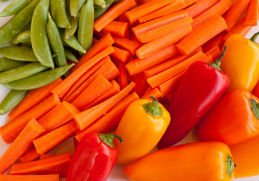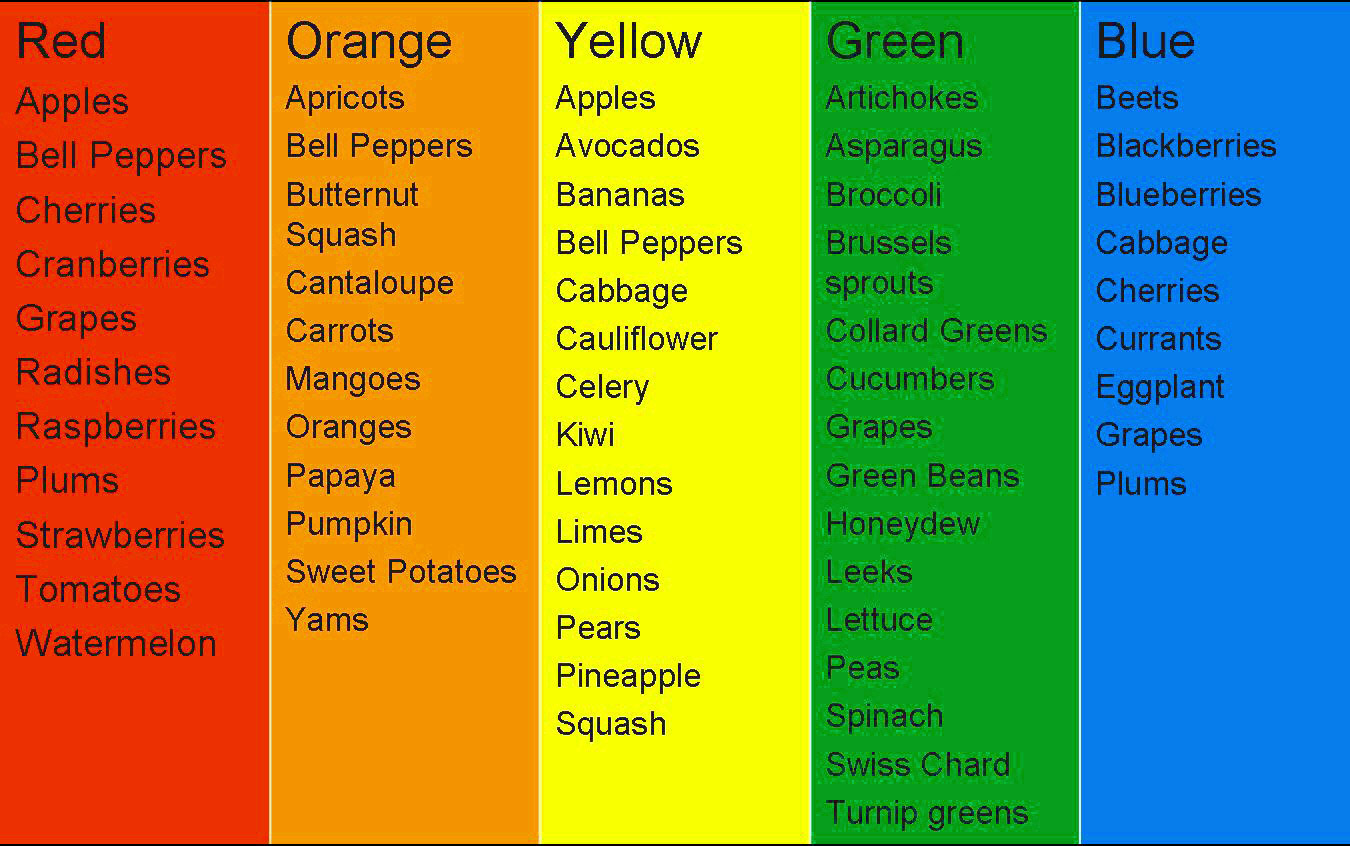Foods that have large quantities of antioxidants are often easy to detect, because many are vividly colored, especially rainbow colored. For instance, carrots and sweet potatoes have plenty of beta-carotene; bell peppers, strawberries and tomatoes contain vitamin C; tomatoes and watermelon have lycopene; and dark leafy greens like spinach contain lutein.
Carotenoids are some of the other common anti-oxidants that our body requires. Carotenoids act as anti-oxidants within the body, shielding against cellular damage, the effects of aging, and even some chronic sicknesses. These useful compounds cannot be manufactured by humans or animals; a diet is the only way to get them. There are well over 600 known carotenoids, with beta-carotene, alpha-carotene, lutein, zeaxanthin, lycopene, and astaxanthin being the most common. These carotenoids are pigmented compounds. These are the pigments that give fruits and vegetables their respective colors. Since these pigments are needed to preserve the health of a person, it is vital to include fruits and vegetables of all colors into your palate.
These carotenoids are pigmented compounds. These are the pigments that give fruits and vegetables their respective colors. Since these pigments are needed to preserve the health of a person, it is vital to include fruits and vegetables of all colors into your palate.
The greatest way to get a great variety of anti-oxidants in the diet is to eat deeply colored plant foods every day as each color indicates unique anti-oxidant properties. Purple and black colored foods are especially valuable.
As a bonus, foods abundant in anti-oxidants are also high in fibre and are outstanding sources of other vitamins, minerals and phytochemicals. However, in certain cases taking high quality antioxidant supplements for a period of time is also highly beneficial as it will substantially speed up healing and regeneration.
Including anti-oxidant foods and drinks in your daily diet can decrease the dangers of cancer and heart disease. The key is to make combinations of these sources of antioxidants in a creative way and add them to your diet plan. The plan should contain deviations so that it can be followed for a long time.
A sample anti-oxidant diet plan that you could follow is to eat some cereal to begin your mornings.
Add some juicy berries to your cereal, they can make it quite tasty! You can also eat raisins, oatmeal, and yoghurt mixed with some fresh blueberries or a glass of fresh fruit juice.
For lunch, kidney beans or red beans can be a healthy addition to salads, pastas, or tacos. You could also include some mixed vegetables along with a fruit to have a complete meal. If you want to eat some meat, you could try a chicken salad with some mixed vegetables.
Drink some green tea during your afternoon break. Green tea has a lot of health benefits and can also make you feel refreshed and calm. For supper you can eat a beef or chicken stir fry with mushrooms, asparagus, and bell peppers. Instead of using lettuce for your sandwich you can also make use of spinach greens.
You can also add some chopped fruits to yoghurt and eat it for dessert.

Fundamentally, foods high in anti-oxidants are also the foods that are commonly considered to be good for you. Hence, if you eat a healthy diet containing lots of fresh fruits and vegetables, you will be able to provide your body with lots of natural anti-oxidants every day. In addition to these natural anti-oxidants, you can also consume them in the form of supplements or get injectable antioxidants.
Some of the better food sources of antioxidants are:
- Berries: Blueberries, blackberries, raspberries, strawberries and cranberries
- Beans: Small red beans and kidney, pinto and black beans
- Fruits: Many apple varieties (with peels), avocados, cherries, green and red pears, fresh or dried plums, pineapple, oranges, and kiwi
- Vegetables: Artichokes, spinach, red cabbage, red and white potatoes (with peels), sweet potatoes and broccoli
- Beverages: Green tea, coffee, red wine and many fruit juices
- Nuts: Walnuts, pistachios, pecans, hazelnuts and almonds
- Herbs: Ground cloves, cinnamon or ginger, dried oregano leaf and turmeric powder
- Grains: Oat-based products
- Dessert: Dark chocolate
Antioxidants can also be found in high quality nutritional supplements, which are suggested by the American Medical Association because most adults do not eat the right foods to appropriately feed their cells.
While supplements can be advantageous, studies show that they are not as effective as eating fruits and vegetables where antioxidants are naturally present. Foods such as onions, tomatoes, grapes, green tea and pomegranates all contain antioxidants. As well, herbs such as rosemary and garlic possess them. Since fruits and vegetables contain other beneficial components, eating them as opposed to a single supplement is much better.
Adequate consumption of antioxidants is a critical part of a healthy diet… but getting too much of isolated!!! antioxidants (via supplements) can in some cases be damaging. So we’d best get the nutrients we need from whole foods, as they’re found in nature, rather than from isolated, synthetic sources (i.e. supplements).
What would you do with $500? Sign up for one of LFBT & Healthline’s free e-News & Tips to enter! »
Regrettably, modern medicine is fixated on isolated, synthetic nutrients and has convinced itself that they have the same favorable properties as nutrients found in whole foods. That is not true. Synthetics are chemically identical yet they structurally differ. And it gets even worse than that. Indeed, there are many aspects to consider in order to sort it all out. Read more here about synthetic and isolated vitamins versus whole-food complexes or 3rd generation vitamins.
But what if not all supplements are bad?
As we’ve already discussed, nature packages nutrients in complexes and, in general, it is best to design supplements using only whole-food complexes. Antioxidants, however, offer one of the few exemptions to that rule, as long as a few conditions are followed.
The cause for the exception is that antioxidants are specialists, not generalists. No single antioxidant is able to effect all free radicals and in every part of the body. For instance, glutathione shields and repairs the liver, whereas bilberry works to defend the eyes. You need to combine various antioxidants in one supplement in order to build an effective full-spectrum defense. In fact, many antioxidants strengthen and/or recycle each other.
To summarize: When it comes to antioxidants, your primary choice should be to include antioxidant rich foods in your diet plan. It guarantees that you’re gaining complete complexes and no synthetics.
The next question will most likely be: what are the best antioxidants and how to rate them? This is the topic of another report, which you can read HERE.
You may also like:
Free Radicals: Enemies Within. What Are They And How Are They Formed
Understanding Antioxidants. How Do They Work?
The Most Common Sources Of Antioxidants
Classification Of The AntiOxidants
How Antioxidants Affect Our Health In General
How You Can Rate The Best Antioxidant? Is ORAC Score A Useful Tool?



